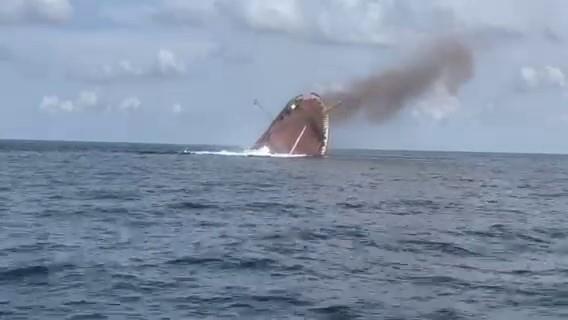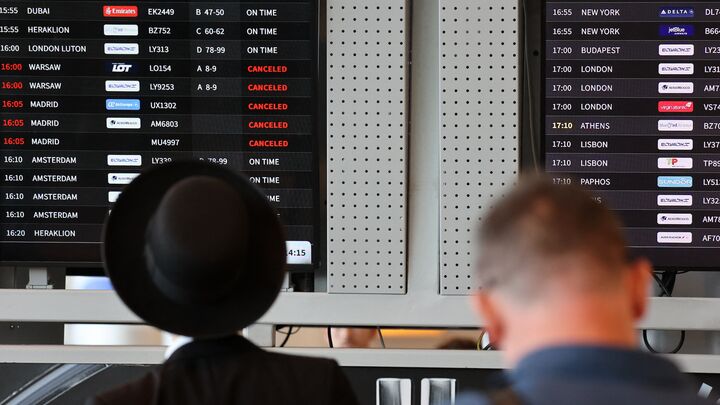B-2 sinks roll-on/roll-off vessel in Gulf of Mexico test
in July, a B-2 used a QUICKSINK munition during the Rim of the Pacific naval exercise near Hawaii, which saw US and allied forces sink two former US Navy amphibious assault ships, the ex-Dubuque and ex-Tarawa. The choice of ships was likely intended as a message to Beijing, which has invested heavily in amphibious assault vessels.
A 2022 QUICKSINK test saw a USAF Boeing F-15E deliver a modified GBU-31 Joint Direct Attack Munition that incorporated a maritime seeker on the nose.
That test, also conducted in the Gulf of Mexico, resulted in the destruction of a full-scale targetIn July, a B-2 used a QUICKSINK munition to strike the retired roll-on/roll-off (ro-ro) vessel M/V Monarch Countess in the Gulf of Mexico near Eglin Air Force base, according to the USAFThe destruction of a ro-ro target is of particular interest, because China is likely to commandeer commercial ro-ro vessels to carry vehicles and personnel should it mount an amphibious invasion against neighbouring Taiwan.
“The development of this technology helps deliver technological superiority to ensure the United States can defend our interests, maintain freedom of action, and seize the initiative over large maritime areas,” says Col. Matthew Caspers of the Air Force Research Laboratory.
Announced in 2022, QUICKSINK is a weapons development programme overseen by the AFRL. The goal is to replicate the ship-killing capability of the US Navy’s MK-48 torpedo in a cheaper, more-flexible air-delivered platform. in July, a B-2 used a QUICKSINK munition during the Rim of the Pacific naval exercise near Hawaii, which saw US and allied forces sink two former US Navy amphibious assault ships, the ex-Dubuque and ex-Tarawa. The choice of ships was likely intended as a message to Beijing, which has invested heavily in amphibious assault vessels.
A 2022 QUICKSINK test saw a USAF Boeing F-15E deliver a modified GBU-31 Joint Direct Attack Munition that incorporated a maritime seeker on the nose.
That test, also conducted in the Gulf of Mexico, resulted in the destruction of a full-scale targetIn July, a B-2 used a QUICKSINK munition to strike the retired roll-on/roll-off (ro-ro) vessel M/V Monarch Countess in the Gulf of Mexico near Eglin Air Force base, according to the USAFThe destruction of a ro-ro target is of particular interest, because China is likely to commandeer commercial ro-ro vessels to carry vehicles and personnel should it mount an amphibious invasion against neighbouring Taiwan.
“The development of this technology helps deliver technological superiority to ensure the United States can defend our interests, maintain freedom of action, and seize the initiative over large maritime areas,” says Col. Matthew Caspers of the Air Force Research Laboratory.
Announced in 2022, QUICKSINK is a weapons development programme overseen by the AFRL. The goal is to replicate the ship-killing capability of the US Navy’s MK-48 torpedo in a cheaper, more-flexible air-delivered platform. in July, a B-2 used a QUICKSINK munition during the Rim of the Pacific naval exercise near Hawaii, which saw US and allied forces sink two former US Navy amphibious assault ships, the ex-Dubuque and ex-Tarawa. The choice of ships was likely intended as a message to Beijing, which has invested heavily in amphibious assault vessels.
A 2022 QUICKSINK test saw a USAF Boeing F-15E deliver a modified GBU-31 Joint Direct Attack Munition that incorporated a maritime seeker on the nose.
That test, also conducted in the Gulf of Mexico, resulted in the destruction of a full-scale targetIn July, a B-2 used a QUICKSINK munition to strike the retired roll-on/roll-off (ro-ro) vessel M/V Monarch Countess in the Gulf of Mexico near Eglin Air Force base, according to the USAFThe destruction of a ro-ro target is of particular interest, because China is likely to commandeer commercial ro-ro vessels to carry vehicles and personnel should it mount an amphibious invasion against neighbouring Taiwan.
“The development of this technology helps deliver technological superiority to ensure the United States can defend our interests, maintain freedom of action, and seize the initiative over large maritime areas,” says Col. Matthew Caspers of the Air Force Research Laboratory.
Announced in 2022, QUICKSINK is a weapons development programme overseen by the AFRL. The goal is to replicate the ship-killing capability of the US Navy’s MK-48 torpedo in a cheaper, more-flexible air-delivered platform. in July, a B-2 used a QUICKSINK munition during the Rim of the Pacific naval exercise near Hawaii, which saw US and allied forces sink two former US Navy amphibious assault ships, the ex-Dubuque and ex-Tarawa. The choice of ships was likely intended as a message to Beijing, which has invested heavily in amphibious assault vessels.
A 2022 QUICKSINK test saw a USAF Boeing F-15E deliver a modified GBU-31 Joint Direct Attack Munition that incorporated a maritime seeker on the nose.
That test, also conducted in the Gulf of Mexico, resulted in the destruction of a full-scale targetIn July, a B-2 used a QUICKSINK munition to strike the retired roll-on/roll-off (ro-ro) vessel M/V Monarch Countess in the Gulf of Mexico near Eglin Air Force base, according to the USAFThe destruction of a ro-ro target is of particular interest, because China is likely to commandeer commercial ro-ro vessels to carry vehicles and personnel should it mount an amphibious invasion against neighbouring Taiwan.
“The development of this technology helps deliver technological superiority to ensure the United States can defend our interests, maintain freedom of action, and seize the initiative over large maritime areas,” says Col. Matthew Caspers of the Air Force Research Laboratory.
Announced in 2022, QUICKSINK is a weapons development programme overseen by the AFRL. The goal is to replicate the ship-killing capability of the US Navy’s MK-48 torpedo in a cheaper, more-flexible air-delivered platform. in July, a B-2 used a QUICKSINK munition during the Rim of the Pacific naval exercise near Hawaii, which saw US and allied forces sink two former US Navy amphibious assault ships, the ex-Dubuque and ex-Tarawa. The choice of ships was likely intended as a message to Beijing, which has invested heavily in amphibious assault vessels.
A 2022 QUICKSINK test saw a USAF Boeing F-15E deliver a modified GBU-31 Joint Direct Attack Munition that incorporated a maritime seeker on the nose.
That test, also conducted in the Gulf of Mexico, resulted in the destruction of a full-scale targetIn July, a B-2 used a QUICKSINK munition to strike the retired roll-on/roll-off (ro-ro) vessel M/V Monarch Countess in the Gulf of Mexico near Eglin Air Force base, according to the USAFThe destruction of a ro-ro target is of particular interest, because China is likely to commandeer commercial ro-ro vessels to carry vehicles and personnel should it mount an amphibious invasion against neighbouring Taiwan.
“The development of this technology helps deliver technological superiority to ensure the United States can defend our interests, maintain freedom of action, and seize the initiative over large maritime areas,” says Col. Matthew Caspers of the Air Force Research Laboratory.
Announced in 2022, QUICKSINK is a weapons development programme overseen by the AFRL. The goal is to replicate the ship-killing capability of the US Navy’s MK-48 torpedo in a cheaper, more-flexible air-delivered platform. in July, a B-2 used a QUICKSINK munition during the Rim of the Pacific naval exercise near Hawaii, which saw US and allied forces sink two former US Navy amphibious assault ships, the ex-Dubuque and ex-Tarawa. The choice of ships was likely intended as a message to Beijing, which has invested heavily in amphibious assault vessels.
A 2022 QUICKSINK test saw a USAF Boeing F-15E deliver a modified GBU-31 Joint Direct Attack Munition that incorporated a maritime seeker on the nose.
That test, also conducted in the Gulf of Mexico, resulted in the destruction of a full-scale targetIn July, a B-2 used a QUICKSINK munition to strike the retired roll-on/roll-off (ro-ro) vessel M/V Monarch Countess in the Gulf of Mexico near Eglin Air Force base, according to the USAFThe destruction of a ro-ro target is of particular interest, because China is likely to commandeer commercial ro-ro vessels to carry vehicles and personnel should it mount an amphibious invasion against neighbouring Taiwan.
“The development of this technology helps deliver technological superiority to ensure the United States can defend our interests, maintain freedom of action, and seize the initiative over large maritime areas,” says Col. Matthew Caspers of the Air Force Research Laboratory.
Announced in 2022, QUICKSINK is a weapons development programme overseen by the AFRL. The goal is to replicate the ship-killing capability of the US Navy’s MK-48 torpedo in a cheaper, more-flexible air-delivered platform. in July, a B-2 used a QUICKSINK munition during the Rim of the Pacific naval exercise near Hawaii, which saw US and allied forces sink two former US Navy amphibious assault ships, the ex-Dubuque and ex-Tarawa. The choice of ships was likely intended as a message to Beijing, which has invested heavily in amphibious assault vessels.
A 2022 QUICKSINK test saw a USAF Boeing F-15E deliver a modified GBU-31 Joint Direct Attack Munition that incorporated a maritime seeker on the nose.
That test, also conducted in the Gulf of Mexico, resulted in the destruction of a full-scale targetIn July, a B-2 used a QUICKSINK munition to strike the retired roll-on/roll-off (ro-ro) vessel M/V Monarch Countess in the Gulf of Mexico near Eglin Air Force base, according to the USAFThe destruction of a ro-ro target is of particular interest, because China is likely to commandeer commercial ro-ro vessels to carry vehicles and personnel should it mount an amphibious invasion against neighbouring Taiwan.
“The development of this technology helps deliver technological superiority to ensure the United States can defend our interests, maintain freedom of action, and seize the initiative over large maritime areas,” says Col. Matthew Caspers of the Air Force Research Laboratory.
Announced in 2022, QUICKSINK is a weapons development programme overseen by the AFRL. The goal is to replicate the ship-killing capability of the US Navy’s MK-48 torpedo in a cheaper, more-flexible air-delivered platform.






